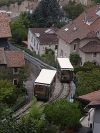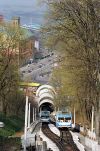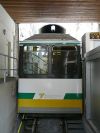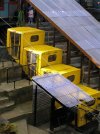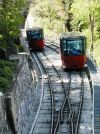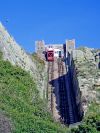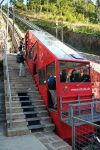

|
 Information portal about all European guided public transportation systems. This site is regularly updated.
Information portal about all European guided public transportation systems. This site is regularly updated. |
|
|
ver.5.0 © 2005-2025, Ing.Michele Tarozzi |
|
FUNICULARS [ 207 cities presented here ] (most recent entries: Feb, 20th, 2017) Funiculars are cable railways with a couple of rail vehicles attached to each other by a cable, which runs through a pulley at the top of the slope. The energy need is minimized by the counterbalancing of the two cars, with one going up and one going down. There are different possible rails configurations such as: two parallel straight tracks with four rails (with separate station platforms for each vehicle), two parallel straight tracks with three rails for the most part of the slope (with the middle rail shared by the 2 cars and four rails only at the by-pass section), two-rails configuration with flanged wheels cars that automatically follow different tracks in the intermediate crossing section. Funiculars are generally characterized by fairly short tracks, with high vertical gradients and only 2 stations (stops) located at the top/botton of the slope. The so called "gravity planes" (also known as self-acting inclines or brake inclines) are a particular kind of funiculars used in mines with the weight of descending loaded wagons used to pull the empty mine wagons. The so called "inclined lift" (also known as inclined elevators or inclinators) are another particular kind of cable systems with only one car carrying payload on the slope. The car is either winched up to the station on the top of the incline where the cable is collected on a winch drum, or alternativly the single car is balanced by a counterweight and operated the same way as a funicular with two cars. click on headers of Location, Country, Line, Opening Year, Length (m), Max Vertical Gradient (%) to sort the data
click the picture for an enlarged view
|
LATEST UPDATES TO THIS SITE
| apm | 19-02-2017 |
| lrt-tram | 27-06-2018 |
| metro | 26-06-2018 | funicular | 20-02-2017 | news | 20-02-2017 |
News 2018
- Jun 18
- - Nizhniy Novgorod: metro extension Moskovskaya-Strelka opened on 13-06-2018
- May 18
- - Saint Petersburg: metro M3 extension Primorskaya-Begovaya opened on 26-05-2018
- - Rome: metro Line C Lodi-San Giovanni opened on 12-05-2017
- Apr 18
- - Lisbon: tram Line 24 Praca Luis Camoes-Campolide reopened on 24-04-2018
- Mar 18
- - Izmir: tram extension Konak Tram Halkapinar-Fahrettin Altay opened on 24-03-2018
- - Moscow: metro Line 10 extension Petrovsko Razumovskaya-Seligerskaya opened on 22-03-2018
- Feb 18
- - Moscow: new metro Line 11 Delovoy Tsentr-Petrovskiy Park opened on 26-02-2018
- Jan 18
- - Dusseldorf: tram Line 701 extension Rath-Am Hulserhof opened on 07-01-2018
Hold mouse over news to pause scrolling
Total size of this site MB 268
www.metrotram.it, v. 5.0
Ing. Michele Tarozzi - (© 2005-2025)












































